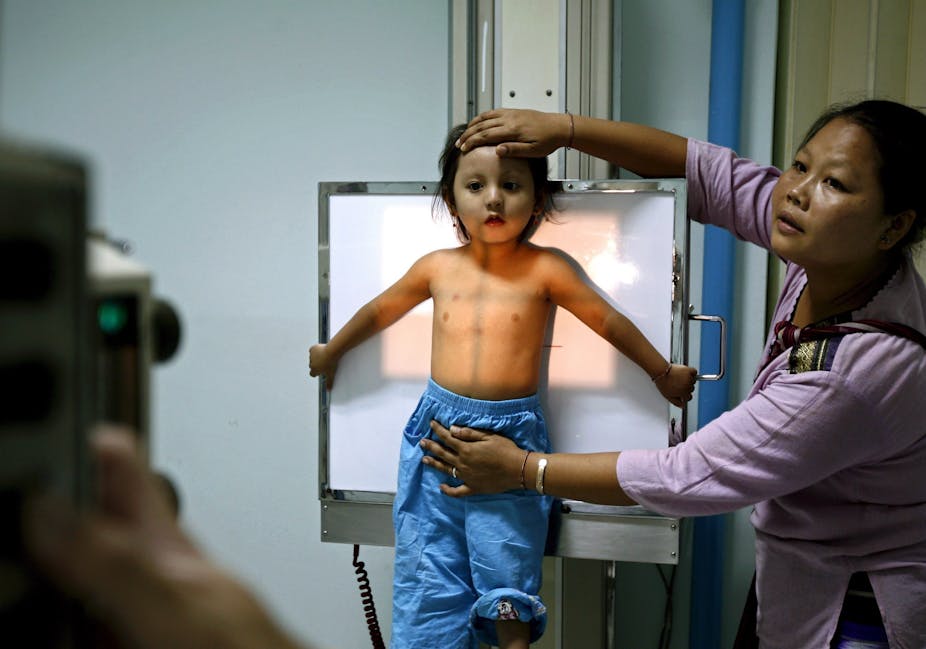
The Electronic Nose breathalyser under development for diagnosing tuberculosis (TB) would, if successful, be an “enormous help” against a disease that killed an estimated 1.4 million people last year, according to Chris Del Mar, Professor of Public Health at Bond University.
Fighting the chronic respiratory infection that plagues much of the developing world is difficult partly to problems with diagnosis, Professor Del Mar said. “It is difficult to diagnose TB; there’s always a danger of false positives and false negatives, so we’re missing people who have got TB and may be transmitting it to other people, and, conversely, we’re thinking people have got TB, because of old scars on their lungs from radiology, but who don’t have it anymore,” Professor Del Mar said. “If this works as well as it promises it might, this could be an enormous help.”
Researchers working on the E-Nose, a hand-held, battery-operated device, were this week awarded US$950,000 ($918,096) by the Bill and Melinda Gates Foundation and Grand Challenges Canada. The project is a collaboration between the International Centre for Genetic Engineering and Biotechnology in New Delhi, and the California-based Next Dimension Technologies, a company specialising in identifying chemicals in vapour. The researchers hope to have clinical tests underway within two years.
Globally, TB has been on the decline for the past 20 years but is still a major threat in poor countries, with the WHO estimating that 8.8 million fell ill with TB in 2010. Professor Del Mar said that the earlier a person was diagnosed and started treatment the better, but that remained a challenge.
“It’s just the nature of the illness. It’s an illness which is a chronic infection, not an acute infection, so people who’ve got it are not obviously sick like they are with pneumonia. And so you can be wandering around carrying TB for a long time without realising and infecting lots of people without anybody realising. There can be long periods in which people can be carrying TB around and it’s doing them harm, but without it being very obvious. You’ll have problems later - you lose weight and all sorts of bad things happen and then you suddenly get very sick at the end,” Professor Del Mar said. Carriers of TB can also kill the most vulnerable - children and people with other illnesses - in short order, by infecting them and sparking an acute eruption of the disease. The WHO estimates that each untreated carrier of TB infects 10 to 15 people per year.
Should the E-Nose work, the challenge remains to keep infected people - who are often very poor - taking their medicine, Professor Del Mar said. “Because it’s a chronic illness, the treatment has to be months long, even years long, and so people sometimes stop taking their treatment and then they relapse.”
Tuberculosis was often formerly called ‘consumption’ due to how it appeared to consume patients’ bodies as they wasted away. The English writer DH Lawrence famously suffered for years before dying at the age of 44 in 1930. Antibiotics became available soon after Lawrence’s death, but prolonged treatment remains necessary due to TB’s physical structure.
“The TB bacillus has a capsule around it which protects it against being dealt with by the immune system, and it also protects it against antibiotics. The other side of that coin is that it’s a very slow-growing bug. A fit, healthy person can sometimes survive their TB without any treatment,” Professor Del Mar said.
After a dramatic drop in preceding decades, the incidence of TB in Australia has been relatively stable since the mid 1980s with higher than average rates in the indigenous and foreign-born sectors of the community. More than 1000 new cases and almost 50 relapses were reported in 2007.
Health officials are concerned that TB rates may creep back up in Australia, Professor Del Mar said. “It’s a disease that gets people when they’re vulnerable. It’s very common amongst people with AIDS; that might be why there’s been such a resurgence of it in the Third World. The worry in Australia is that we’re getting a lot of people with chronic diseases like diabetes, and they are at risk of getting TB while they’re debilitated.”
Type two diabetes is the fastest growing chronic disease in Australia - an escalation health authorities closely relate to the doubling of the prevalence of obesity in the past 20 years. About 60 per cent of Australians are now classed as overweight or obese.

